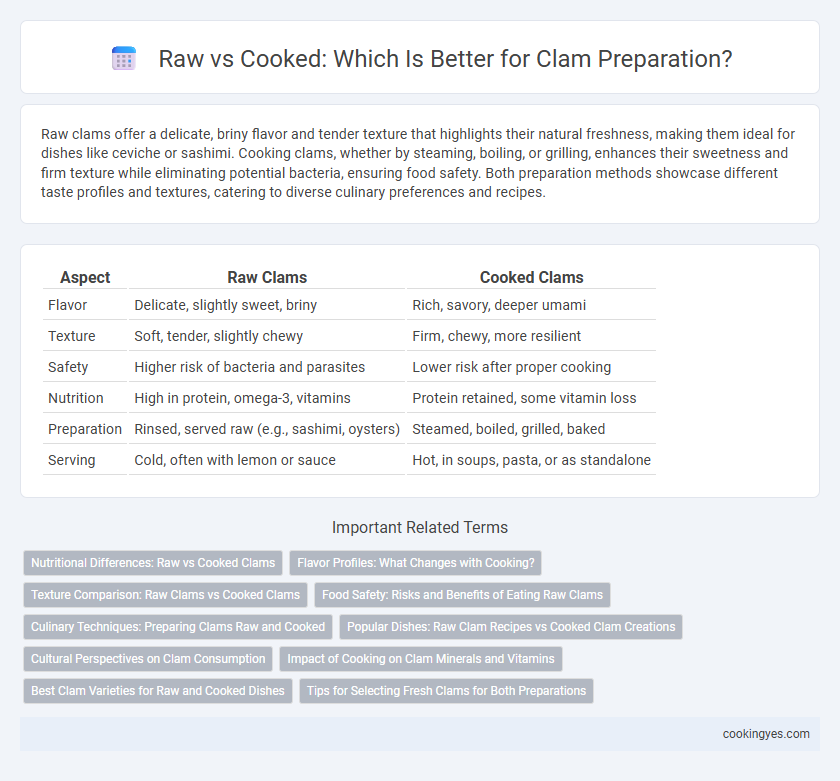Raw clams offer a delicate, briny flavor and tender texture that highlights their natural freshness, making them ideal for dishes like ceviche or sashimi. Cooking clams, whether by steaming, boiling, or grilling, enhances their sweetness and firm texture while eliminating potential bacteria, ensuring food safety. Both preparation methods showcase different taste profiles and textures, catering to diverse culinary preferences and recipes.
Table of Comparison
| Aspect | Raw Clams | Cooked Clams |
|---|---|---|
| Flavor | Delicate, slightly sweet, briny | Rich, savory, deeper umami |
| Texture | Soft, tender, slightly chewy | Firm, chewy, more resilient |
| Safety | Higher risk of bacteria and parasites | Lower risk after proper cooking |
| Nutrition | High in protein, omega-3, vitamins | Protein retained, some vitamin loss |
| Preparation | Rinsed, served raw (e.g., sashimi, oysters) | Steamed, boiled, grilled, baked |
| Serving | Cold, often with lemon or sauce | Hot, in soups, pasta, or as standalone |
Nutritional Differences: Raw vs Cooked Clams
Raw clams retain higher levels of vitamin C and certain heat-sensitive antioxidants, while cooking enhances mineral bioavailability such as iron and zinc by breaking down tough proteins. Cooking methods like steaming or boiling reduce potential pathogens and improve digestibility without significantly diminishing omega-3 fatty acids. Nutrient density varies, with cooked clams providing more bioavailable iron and protein, essential for immune function and muscle maintenance.
Flavor Profiles: What Changes with Cooking?
Raw clams offer a briny, ocean-fresh flavor with a tender, slightly chewy texture that highlights their natural sweetness. Cooking clams intensifies their umami notes, softens the texture, and can introduce smoky or buttery flavors depending on the method used. Heat alters the clam's protein structure, which enhances depth and richness, making cooked clams versatile for various culinary applications.
Texture Comparison: Raw Clams vs Cooked Clams
Raw clams offer a smooth, tender texture with a slight chewiness that retains the briny freshness of the sea. Cooked clams develop a firmer, more resilient texture that varies from slightly chewy to tender depending on the cooking method and duration. Steaming or boiling enhances the clam's natural texture while frying creates a crispy exterior with a soft interior.
Food Safety: Risks and Benefits of Eating Raw Clams
Eating raw clams carries a higher risk of exposure to harmful bacteria such as Vibrio vulnificus and norovirus, which can cause severe foodborne illnesses, especially in individuals with compromised immune systems. Cooking clams thoroughly at an internal temperature of 145degF (63degC) kills pathogens and significantly reduces health risks, ensuring safer consumption. While raw clams offer a fresh, natural flavor and retain more nutrients, prioritizing food safety through proper handling and sourcing from reputable suppliers is essential to minimize contamination hazards.
Culinary Techniques: Preparing Clams Raw and Cooked
Raw clams offer a delicate, briny flavor and a tender texture ideal for dishes like sashimi or ceviche, requiring careful shucking and cleaning to ensure safety and freshness. Cooking methods such as steaming, grilling, or baking enhance the clam's natural sweetness and firm up its texture, with steaming being a popular technique that opens shells quickly while preserving moisture. Proper heat control and timing are essential to prevent overcooking, which can render clams tough and rubbery, highlighting the importance of precise culinary techniques in clam preparation.
Popular Dishes: Raw Clam Recipes vs Cooked Clam Creations
Raw clam recipes like classic clam ceviche and Japanese sashimi highlight the seafood's natural briny flavor and tender texture, offering a fresh, oceanic experience. Cooked clam dishes such as clam chowder, linguine with clam sauce, and steamed clams emphasize warmth and depth, often enhanced by herbs, garlic, and butter for rich, savory profiles. Both preparation methods celebrate clams' versatility in popular cuisines, catering to diverse taste preferences and culinary traditions.
Cultural Perspectives on Clam Consumption
Raw clam consumption is highly valued in Japanese cuisine, where freshness and texture are paramount, often served as sashimi or sushi. In contrast, many Western cultures prefer cooked clams to enhance flavor and ensure safety, commonly boiling or steaming them in dishes like clam chowder or pasta. These cultural practices reflect differing attitudes toward seafood safety, texture appreciation, and traditional culinary methods across regions.
Impact of Cooking on Clam Minerals and Vitamins
Cooking clams can significantly alter their mineral and vitamin content; heat reduces water-soluble vitamins such as vitamin B12 and vitamin C while concentrating minerals like iron and zinc due to water loss. Raw clams preserve more of their delicate vitamins but pose a higher risk of bacterial contamination. Optimal preparation balances nutrient retention and food safety, favoring methods like steaming that minimize nutrient degradation.
Best Clam Varieties for Raw and Cooked Dishes
Cherrystone and Littleneck clams are ideal for raw preparation due to their tender texture and briny, sweet flavor, making them perfect for dishes like clam chowder and raw bar platters. Manila clams, prized for their delicate taste, are versatile, excelling both raw in ceviches and cooked in sautes or pasta dishes. Larger species such as Quahogs and Razor clams develop richer flavors when cooked, making them preferable for grilling, steaming, or baking to enhance their texture and innate taste.
Tips for Selecting Fresh Clams for Both Preparations
Select clams with tightly closed shells or those that close when tapped, as this indicates freshness and prevents contamination in both raw and cooked preparations. Check for a clean, ocean-like scent and avoid clams with cracked or broken shells to ensure optimal taste and safety. Store clams in a breathable container covered with a damp cloth at refrigerated temperatures to maintain freshness before preparation.
Raw vs cooked for clam preparation Infographic

 cookingyes.com
cookingyes.com